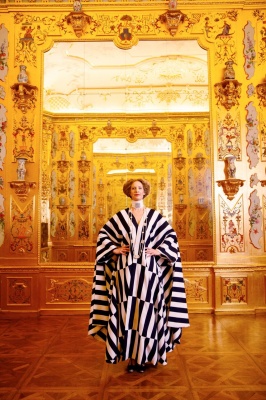Beloved Muse
21/09/2018 - 23/09/2018
Production Details
Emilie Flöge was the life companion and muse of Austrian painter Gustav Klimt. Beloved Muse tells the story of this remarkable woman who not only modelled for many of his paintings, including The Kiss (arguably Klimt’s most famous work) but was a businesswoman and fearless fashion designer.
Direct from Austria, the Festival presents Maxi Blaha in this solo play.
From the glamour of high society Vienna, through the devastation of two world wars, from running a hugely successful haute couture fashion house which smashed the constraints of women’s clothing, to joining the world suffrage movement, Emilie Flöge’s story is bursting with passion and revolution.
Maxi Blaha is full of energy and bravura as Emilie Flöge. Beloved Muse marks both this year’s centenary celebration of Klimt and New Zealand’s Suffrage 125.
Friday 21 – Sunday 23 Sept, 7.30pm
The Savoy
General Admission Adult $35/$25
http://www.artsfestivaldunedin.co.nz/festival-programme/theatre/beloved-muse
Maxi Blaha
Theatre ,
70 minutes
A fitting festival opener
Review by Allie Cunninghame 22nd Sep 2018
Beloved Muse is an examination of art, fashion, and the nature of love. Written by Penny Black this year to mark the centenary of the death of Gustav Klimt, it is a solo performance by Maxi Blaha, who takes on the role of Emilie Flöge, fashion designer and Klimt’s life companion. The role was written for Blaha, whose physicality is perfect – tall and elegant and aloof, she could have stepped from one of the canvases of the artist.
The play, which is directed by Heidelinde Leutgöb, examines the story behind the woman in Klimt’s most famous painting. Modern audiences are familiar with the concept of histories rewritten to centre minorities, with the concept of ‘herstory’. This recentering of the woman depicted in ‘The Kiss’ is a fitting way to open the Dunedin Arts Festival, which comes at the end of Suffrage Week.
Flöge is complicated, and the woman depicted in this play is not particularly easy to like. She speaks about how her fashions emancipated women, freeing them from corsets and allowing them to explore in the forests, but she also values the way in which clothes can make a woman more attractive – chokers, for example, hide problematic chins. Her first dresses were designed after she worked on improving maid’s aprons, but she sees the revolutionary element of her three-pocketed aprons not being in how they enable women to work more easily, but in how they improved the maids’ posture.
Similarly, when she laments the effects of the First World War on Austria, Flöge speaks of how her customers would come to her to have dresses taken in, but this seems to distress her not because of the starvation and stress that was affecting the women, but because the fabrics and designs were compromised by alteration. There is no intersectionality in Flöge’s feminism. Blaha therefore has to inhabit a role which seems otherworldly to her audience, and it is hard to emotionally connect with her.
Her most relatable moments come with her acerbic asides about Klimt’s lovers (and there were many lovers and ‘Little Klimts’ – at these times her mask slips and we see the woman behind. The play is a mediation on grief, and on a person’s place in a loved one’s life. Recalling the way in which we all differently handle loss also informs a more sympathetic view.
In one vignette, Blaha speaks to the audience while she cuts paper, revealing a string of paper dolls. Metaphors abound here: paper dolls, and young girls’ first forays into fashion and design; the flimsy depiction of the female form, created through scissors and cut into a uniform sameness. The women in Klimt’s paintings are ethereal and unknowable. Black’s script offers a critique of how these women are depicted, and hints at Klimt’s inability or unwillingness to present their real physical selves, but Blaha’s reserve and poise keeps the real self of Flöge from the audience, too.
The set design is simple, but the Dunedin performance is enhanced by the performance space – the salon at the Savoy, with its wood panelling and ornate plasterwork, recalls grand buildings in Europe. Blaha is dressed in an extraordinary gown which juxtaposes with the performance space, reinforcing the way in which Flöge’s designs would have seemed revolutionary at the turn of the earlier century.
Blaha’s performance is accompanied by Georg Buxhofer, whose atmospheric guitar heightens emotions and provides some moments of comedy. Blaha sings beautifully and it is presumably because of this that she wears a microphone throughout the performance but the microphone distracts from the clean lines of her face, which is a shame. I wonder whether it is necessary in the relatively small performance space.
Blaha and Black are both very accomplished indeed, and Dunedin audiences are lucky to have the opportunity to see this work performed by its enigmatic muse. The performance is a fitting way to open this year’s festival.
Copyright © in the review belongs to the reviewer





Comments